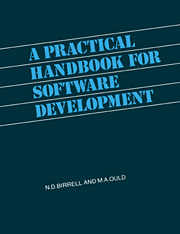Book contents
- Frontmatter
- Contents
- Foreword
- Preface
- 1 The choices facing the system developer
- 2 The software development process
- 3 Development techniques
- 4 Project Inception
- 5 System Definition
- 6 System Design
- 7 System Production
- 8 System Acceptance and Post-Acceptance Development
- 9 Project Debriefing
- Other bibliographies
- References
- Index
8 - System Acceptance and Post-Acceptance Development
Published online by Cambridge University Press: 11 January 2010
- Frontmatter
- Contents
- Foreword
- Preface
- 1 The choices facing the system developer
- 2 The software development process
- 3 Development techniques
- 4 Project Inception
- 5 System Definition
- 6 System Design
- 7 System Production
- 8 System Acceptance and Post-Acceptance Development
- 9 Project Debriefing
- Other bibliographies
- References
- Index
Summary
The aims of System Acceptance
The system resulting from the Production Phase must now be tested against the Functional Specification to your client's satisfaction. There are two principal reasons for giving the System Acceptance process a phase of its own:
firstly, to emphasise the importance of careful preparation for it and proper orientation of the preceding phases towards it;
secondly, because possibly for the first time since System Definition and the production of the Functional Specification, your client will once more play a major role.
Formal acceptance of the system by your client – in other words, a signature – is as important as his formal acceptance of the Functional Specification. It records his agreement that you have carried out your commitment to build his system.
It is likely that, if you have a commercial contract with your client, payment of some portion of the contract price will be dependent on the system's successfully passing an agreed Acceptance Test.
Throughout the preceding phases we have emphasised the need to prepare for Acceptance well ahead of the date of handover. The earlier the Acceptance Test is defined, for instance, the earlier the system can be checked out against it by its implementers. Above all, however, acceptance will not always be simply a matter of running some tests on the system and walking away. You may well be involved in a major handover operation requiring the conversion of the user's organisation and operational procedures, cutover from an existing system, conversion of existing databases to new formats, periods of parallel running, training of staff and so on.
- Type
- Chapter
- Information
- A Practical Handbook for Software Development , pp. 222 - 225Publisher: Cambridge University PressPrint publication year: 1985



